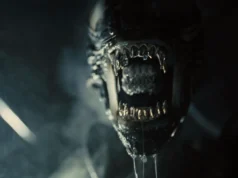“Action set-pieces aside, — the film’s characters and themes are greatly lacking.”
Paul W.S. Anderson’s Pompeii seems to try to play with the Motion Picture Association of America’s (MPAA, the company that assigns ratings to the films you see) emotions in the regard that it constantly seems to be testing how violent a PG-13 film can be before the rating is bumped up to a R. Pompeii‘s graphicness in terms of gore is moderately tame, but by the fourth or fifth gladiator fight, I can’t say that I wasn’t trying to fathom how the MPAA assigns the dreaded NC-17 rating to a film that uses a bit more graphic nudity than others but doesn’t dare budge on its ratings for very violent films like Pompeii or The Passion of the Christ.
Moreover, the film is set in AD 79, not long before the inevitable volcano eruption will wipe out the city of Pompeii. We focus on Milo (Kit Harington), a slave-turned-gladiator who meets the wonderful Cassia (Emily Browning), the daughter of an affluent man who has fallen to the corruption of the Roman Senator Corvus (Kiefer Sutherland). Milo also needs to find a way to defeat Atticus (Adewale Akinnuoye-Agbaje), a fearless and extremely powerful gladiator, while rescuing those he loves upon the eruption of Mount Vesuvius.
- Pompeii
- Directed by
Paul W.S. Anderson - Cast
Kit Harington, Emily Browning, Kiefer Sutherland - Release Date
21 February 2014 - Steve’s Grade: C+
Pompeii has a rare, macro-budget charm to it, and my praise for its action sequences, which are conducted on a grand-scale, will no doubt surprise my consistent readers, who know I don’t take too kindly to lengthy action scenes. Simply put, many of Pompeii‘s action sequences are a riveting good time. Consider one scene when a man is walking across a heavily-grassy plane when, all of a sudden, swamp-like conditions take effect and he drowns when the grass turns to water. Or even the scene when Milo is fighting in a Colosseum, trotting along on a horse around the perimeter of the arena, with a chain wrapped around him and tethered to the centerpiece in the middle of the Colosseum. Milo trots around on the horse, while the chain clotheslines those trying to stop him.
Then there’s the volcanic eruption, which may as well be credited as an actor itself. The attention-to-detail with the eruption of Mount Vesuvius here is beyond exquisite and, while it may last for an upwards of a half hour, the excitement never seems to run out of momentum. We see how the volcano destroys everything in Pompeii, leaving nothing behind whatsoever. We see its impact from every perspective, which only makes it more enticing to watch.
[widgets_on_pages id=”AdSenseArticleBanner”]
Action set-pieces aside, and to return to sounding like myself again, the film’s characters and themes are greatly lacking. Milo is only noble because the movie says he is, the Roman Senator is only menacing because the movie needs a villain, and there doesn’t appear to be any takeaway moral or theme to the story, which applies it with an disquieting feeling of emptiness. I feel with many films centered on mythology or ancient-history the costume designers’ hours get overextended and are brutally overworked on set, while the script-writers sit and relax for much of the picture’s production. Many of these films work hard to establish believable costumes and artillery, but skimp out on anything resembling true human interest.
In this case, Pompeii does just that, but also forgets to integrate a theme and effectively elevate the method to its madness. This makes its material more facile than it could’ve been. Not to mention, the tacked on romantic element at the end operates as if two minutes of Endless Love were spliced into the film, shamelessly catering to the girlfriends and wives dragged to this picture by their significant others craving action.
With all this said and done, Pompeii is still a moderately-adept action film, complete with strong, enticing visuals and a cast of adequate performers. Anderson also seems to employ some delightful symbolism in later shots to add to a deeper meaning (aerial shots that could very well articulate the thought of a God looking down on a city that he’s about to completely destroy). The entire thing is a graphic romanticization of inevitable fatalism that finds many ways to be artful in its chaotic sequences.
Review by Steve Pulaski, Lead Film Critic






